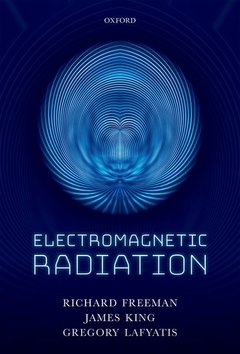Description
Electromagnetic Radiation
Authors: Freeman Richard, King James, Lafyatis Gregory
Language: English
Subject for Electromagnetic Radiation:
52.22 €
In Print (Delivery period: 21 days).
Add to cart
Electromagnetic Radiation
Publication date: 02-2024
640 p. · 17.3x24.5 cm · Paperback
Publication date: 02-2024
640 p. · 17.3x24.5 cm · Paperback
83.99 €
In Print (Delivery period: 21 days).
Add to cart
Electromagnetic Radiation
Publication date: 01-2019
638 p. · 18x24.9 cm · Hardback
Publication date: 01-2019
638 p. · 18x24.9 cm · Hardback
Description
/li>Biography
/li>
Electromagnetic Radiation is a graduate level book on classical electrodynamics with a strong emphasis on radiation. This book is meant to quickly and efficiently introduce students to the electromagnetic radiation science essential to a practicing physicist. While a major focus is on light and its interactions, topics in radio frequency radiation, x-rays, and beyond are also treated. Special emphasis is placed on applications, with many exercises and problems. The format of the book is designed to convey the basic concepts in a mathematically rigorous manner, but with detailed derivations routinely relegated to the accompanying side notes or end of chapter "Discussions". The book is composed of four parts: Part I is a review of basic E&M (electricity and magnetism), and presents a concise review of topics covered in the subject. Part II addresses the origins of radiation in terms of time variations of charge and current densities within the source, and presents Jefimenko's field equations as derived from retarded potentials. Part III introduces special relativity and its deep connection to Maxwell's equations, together with an introduction to relativistic field theory, as well as the relativistic treatment of radiation from an arbitrarily accelerating charge. A highlight of this part is a chapter on the still partially unresolved problem of radiation reaction on an accelerating charge. Part IV treats the practical problems of electromagnetic radiation interacting with matter, with chapters on energy transport, scattering, diffraction and finally an illuminating, application-oriented treatment of fields in confined environments.
Richard Freeman received his undergraduate degree in physics from the University of Washington and his Ph.D. from Harvard studying molecular interactions under Norman Ramsey in 1973. He did post-doctoral work at MIT investigating Rydberg atoms under Daniel Kleppner. He spent 20 years at Bell Laboratories developing experimental tools to understand the effects of intense light on atoms and molecules. In 1996, he moved to the University of California where he continued his interests in intense light interactions with matter. In 2003, he was appointed Dean of Mathematical and Physical Sciences at The Ohio State University where he continued his studies of matter under extreme conditions. James A. King received a Bachelor's degree in Physics and a PhD in Applied Science from University of Nevada, Las Vegas and University of California, Davis, respectively. He worked at LLNL as a graduate student and at UCSD and OSU and a postdoctoral researcher. Presently he is employed by NSTec. Gregory Lafyatis received his undergraduate degree in electrical engineering from MIT and Ph. D in physics from Harvard where he experimentally studied atomic and molecular processes of astrophysical interest. His post-doctoral work included helping to develop a single ion trap for use in ultra-high precision mass spectroscopy and early work in trapping laser cooled neutral atoms. In his faculty position at Ohio State University, he has made contributions in a variety of atomic, molecular, and optical physics including cold atom experiments, condensed matter motivated atomic beam experiments, biologically motivated optical tweezer experiments, and single photon detectors for quantum information applications.
© 2024 LAVOISIER S.A.S.




